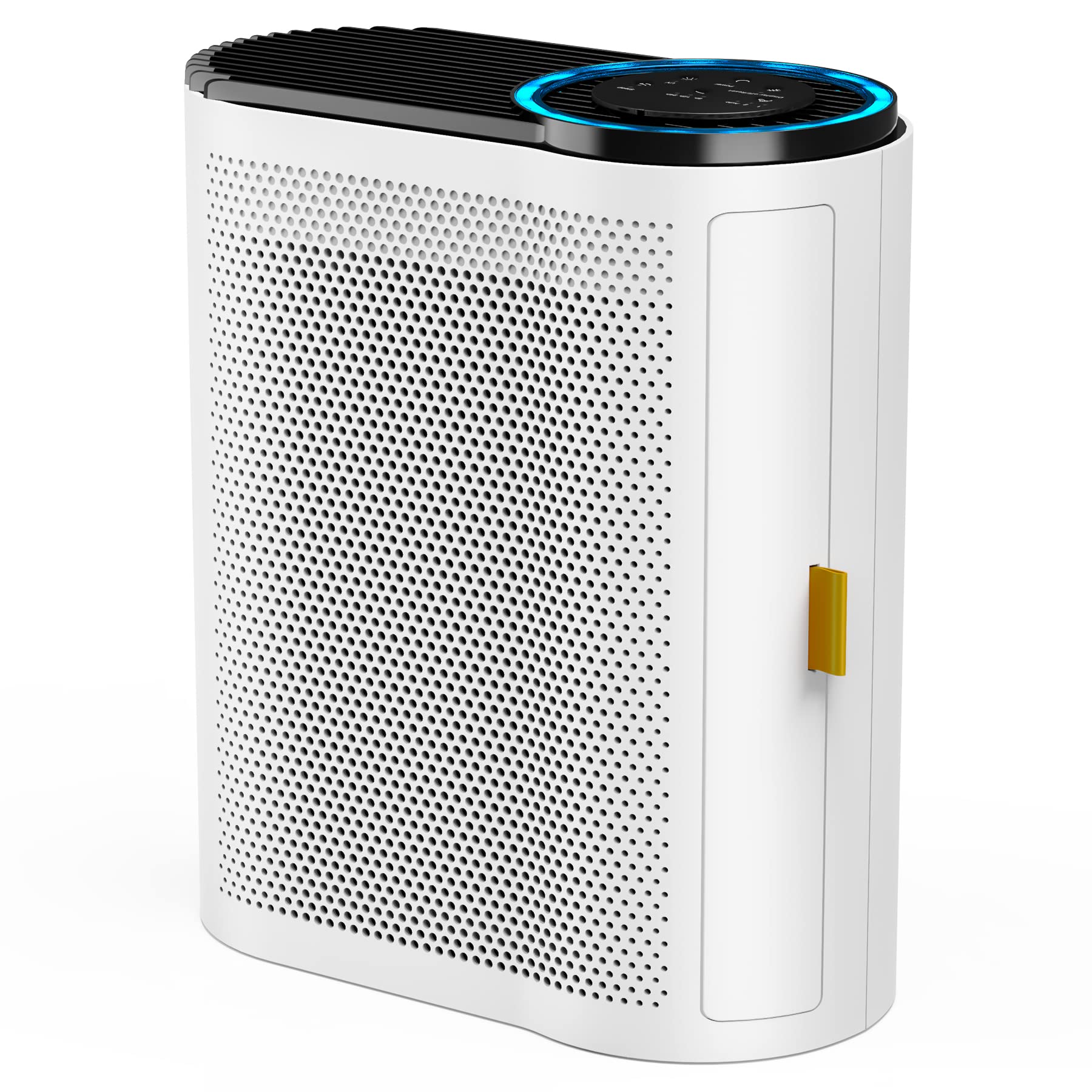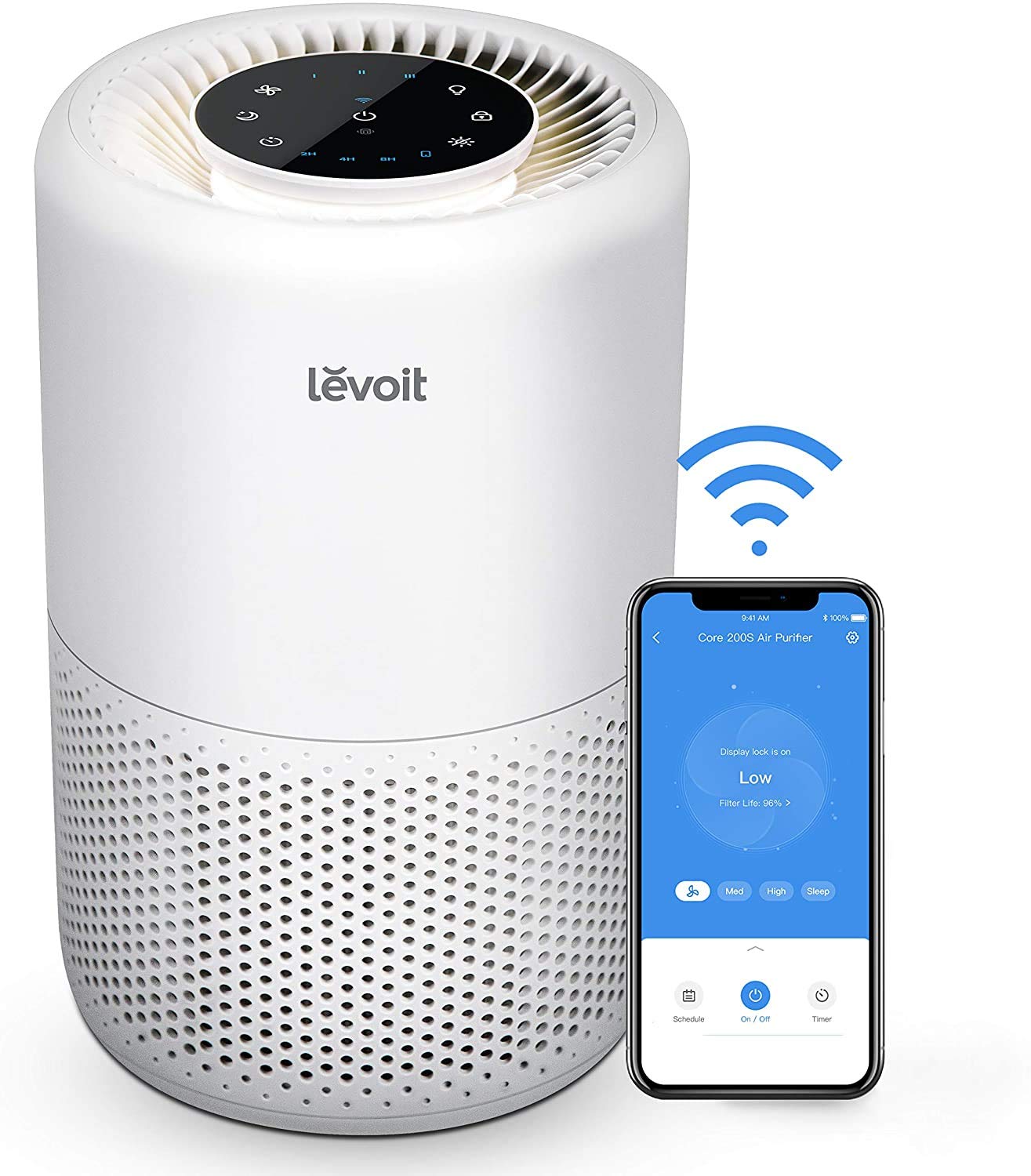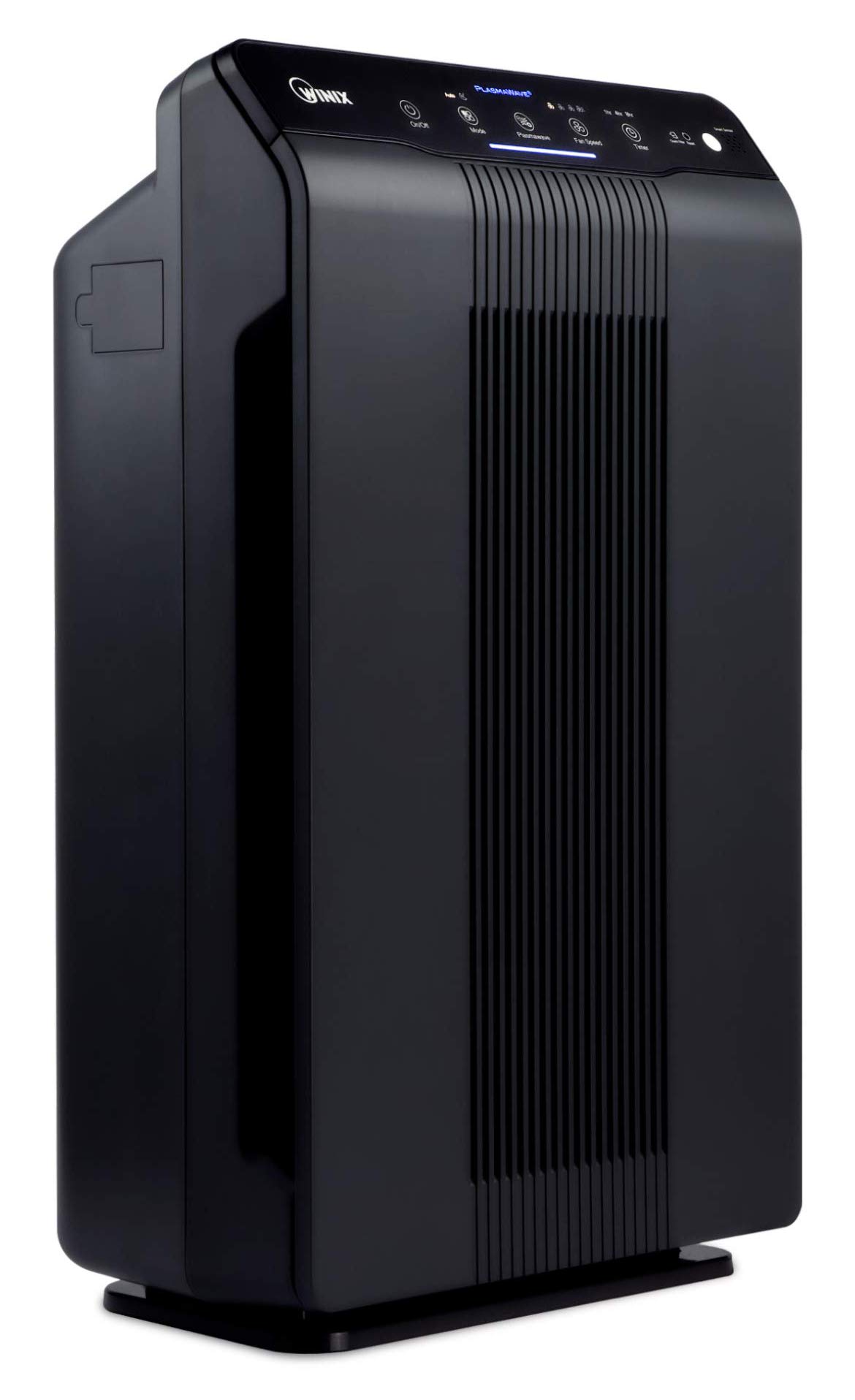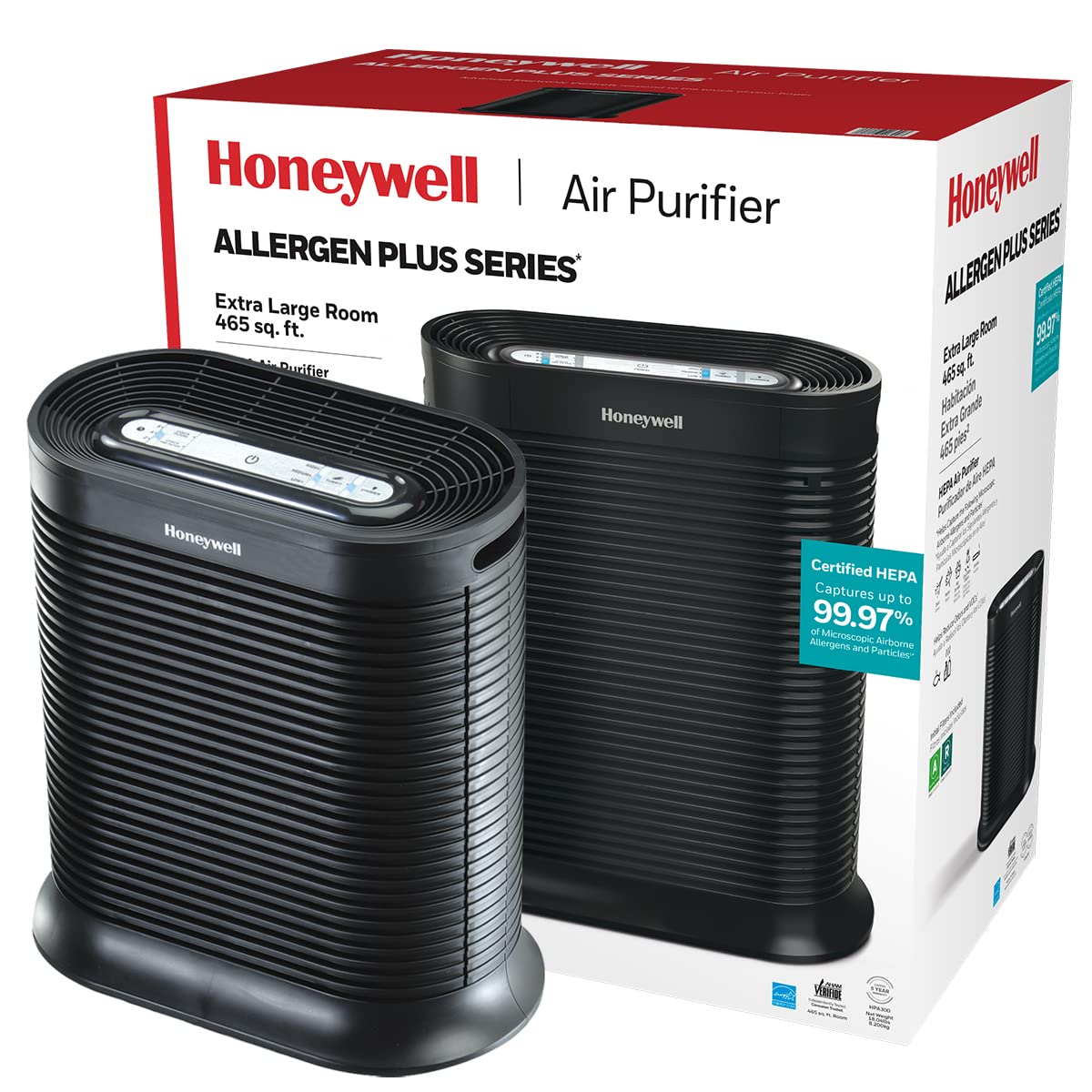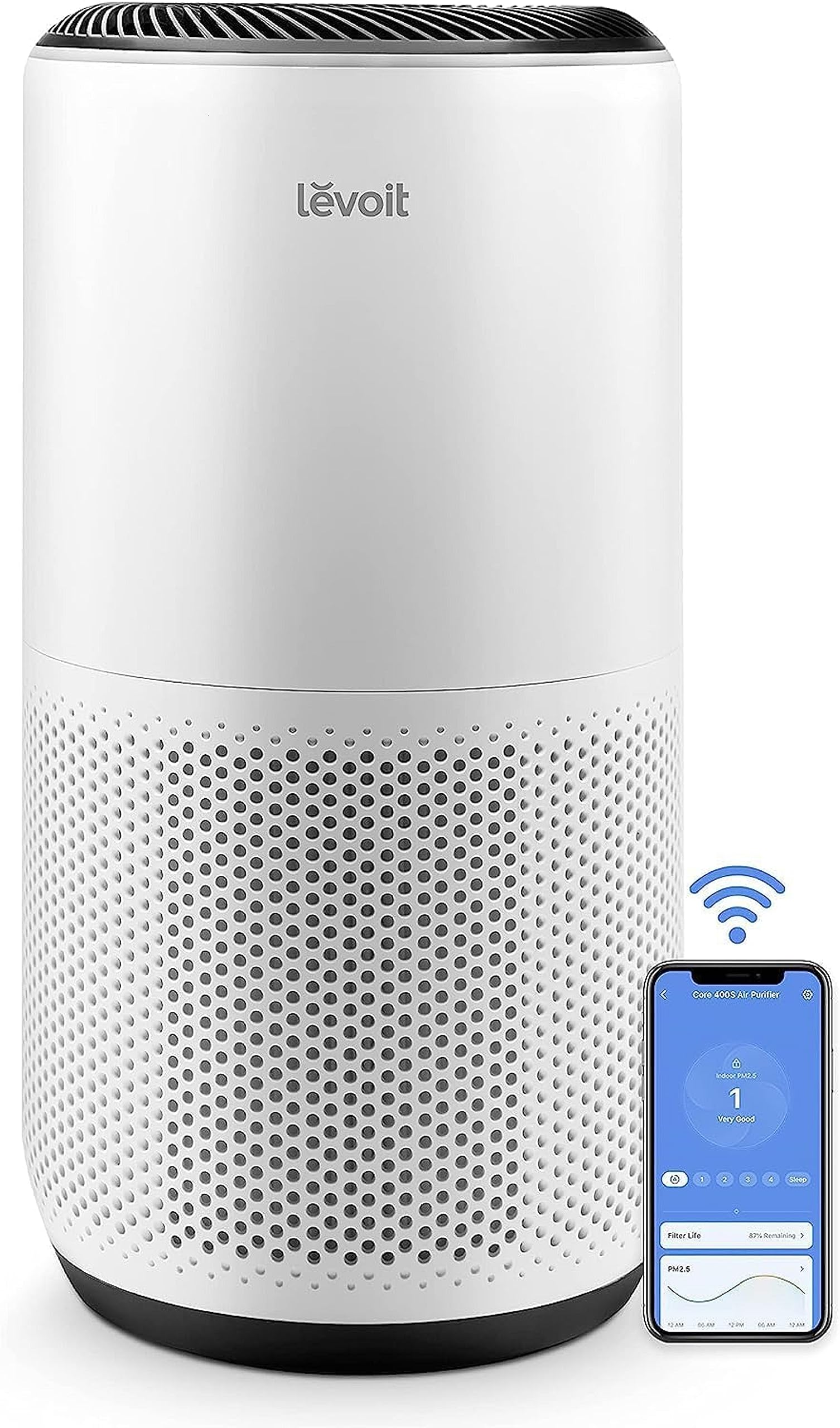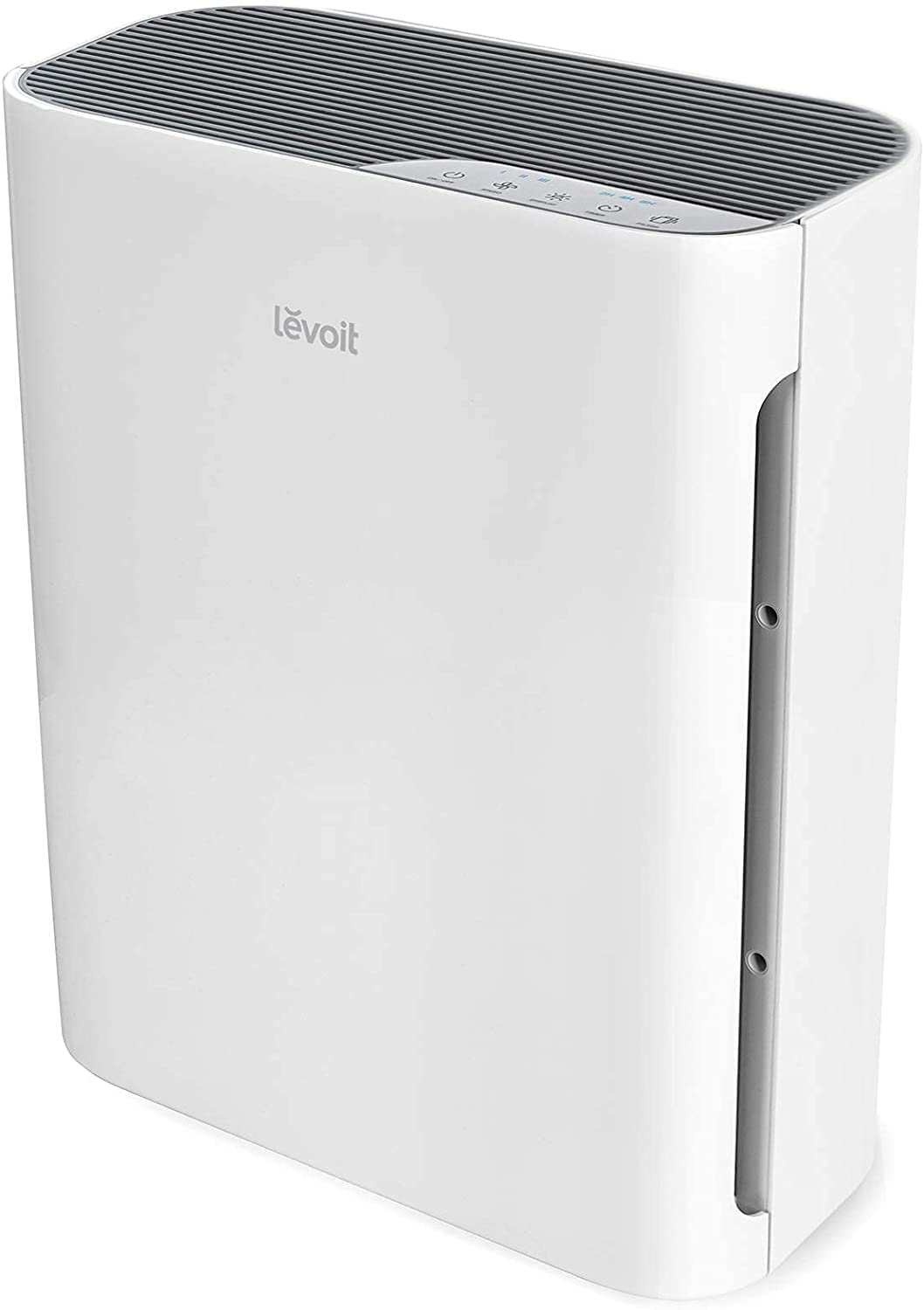FAQs - Advanced Queries
Why Do You Need an Air Purifier

Why is an air purifier necessary when I am surrounded by stale, polluted air in my home?
The answer lies in the invisible dangers that lurk within our indoor spaces. Indoor air pollution, filled with allergens, mold spores, and harmful chemicals, can wreak havoc on our health.
But fear not, for an air purifier is the knight in shining armor, ready to cleanse the air of these unseen foes.
Let’s dive deep into the scientific evidence and explore the undeniable benefits of having an air purifier in your home.
Key Takeaways
- Exposure to indoor air pollutants can lead to respiratory conditions like asthma and COPD.
- Air pollution may also affect cognitive function and contribute to neuroinflammation and neurodegenerative diseases.
- Addressing indoor air pollution is crucial for safeguarding respiratory health and cognitive well-being.
- Air purifiers can filter out harmful chemicals and VOCs found in cleaning products, paints, and furniture, providing cleaner indoor air.
The Impact of Indoor Air Pollution
Indoor air pollution can have a significant impact on our health and well-being. Understanding respiratory illnesses is crucial in recognizing the dangers of air pollution.
Studies have shown that exposure to indoor air pollutants can lead to various respiratory conditions, such as asthma and chronic obstructive pulmonary disease (COPD). These pollutants, including particulate matter, volatile organic compounds (VOCs), and biological agents, can irritate the airways and cause inflammation, leading to respiratory symptoms and reduced lung function.
Additionally, emerging research suggests that air pollution may also affect cognitive function. Fine particulate matter, for example, can reach the brain and potentially contribute to neuroinflammation and neurodegenerative diseases.
Therefore, it is essential to address indoor air pollution to safeguard our respiratory health and cognitive well-being. Understanding the impact of airborne allergens further highlights the importance of air purification.
Understanding Airborne Allergens
To better comprehend airborne allergens, it’s essential to understand the types of particles that can trigger allergic reactions and how they can infiltrate your living environment.
-
Pollen: These tiny grains, released by plants and trees, are a common trigger for respiratory conditions like hay fever.
-
Dust mites: These microscopic creatures thrive in warm and humid environments, and their waste particles can cause nasal congestion and sneezing.
-
Pet dander: Shed skin cells from pets contain allergenic proteins that can lead to itchy eyes, coughing, and wheezing in susceptible individuals.
-
Mold spores: Mold grows in damp areas and releases spores into the air, which can cause respiratory symptoms such as coughing, wheezing, and shortness of breath.
Understanding these allergens is crucial in managing indoor allergies and protecting your respiratory health. By identifying potential sources and implementing effective strategies, such as using air purifiers, you can create a healthier living environment.
This is particularly important because poor indoor air quality can have harmful effects on our health and well-being.
Harmful Effects of Poor Indoor Air Quality
Exposure to poor indoor air quality can lead to various health issues, such as respiratory problems and allergies. The importance of ventilation cannot be overstated when it comes to maintaining good indoor air quality. Proper ventilation helps to remove pollutants and improve air circulation, reducing the risk of health problems.
However, in some cases, ventilation alone may not be enough to combat indoor air pollution. This is where air purifiers play a crucial role. Air purifiers are devices designed to remove harmful particles from the air, such as dust, pollen, pet dander, and even some viruses and bacteria. By capturing and trapping these pollutants, air purifiers can significantly reduce the presence of respiratory irritants in the indoor environment, thereby alleviating symptoms and improving overall air quality.
Research has shown that using air purifiers can effectively reduce respiratory symptoms, such as coughing, wheezing, and sneezing, particularly in individuals with allergies or asthma. Therefore, investing in an air purifier can be a practical solution to improve indoor air quality and protect our respiratory health.
Health Benefits of Using an Air Purifier
Using an air purifier can effectively reduce respiratory symptoms, such as coughing and sneezing. Research has shown that air purifiers provide numerous benefits for improving respiratory health:
-
Removes airborne allergens: Air purifiers can filter out common allergens like pollen, dust mites, and pet dander, reducing the triggers for respiratory allergies.
-
Eliminates harmful pollutants: Indoor air can contain pollutants such as volatile organic compounds (VOCs), tobacco smoke, and mold spores. Air purifiers can remove these harmful substances, improving the air quality.
-
Reduces asthma attacks: By removing asthma triggers like dust and pet dander, air purifiers can help reduce the frequency and severity of asthma attacks.
-
Filters out bacteria and viruses: Some air purifiers are equipped with HEPA filters that can capture tiny particles, including bacteria and viruses, reducing the risk of respiratory infections.
Investing in an air purifier can significantly benefit your respiratory health by providing cleaner and healthier indoor air.
Common Sources of Indoor Air Pollution
As I delve into the topic of common sources of indoor air pollution, it is crucial to address three key points: harmful household chemicals, pet dander and fur, and mold and mildew.
These sources are not only prevalent but also pose significant risks to our health. Harmful household chemicals, such as cleaning agents and air fresheners, release volatile organic compounds (VOCs) that can cause respiratory issues and other health problems.
Pet dander and fur, although seemingly harmless, can trigger allergies and asthma attacks in susceptible individuals.
Lastly, the presence of mold and mildew can lead to respiratory issues and exacerbate existing conditions, particularly in those with compromised immune systems.
Understanding these sources is essential for effectively managing indoor air quality and safeguarding our well-being.
Harmful Household Chemicals
To protect yourself from harmful household chemicals, it is essential to consider having an air purifier in your home. Air purifiers are effective tools for removing pesticides and reducing indoor toxins. Here are four reasons why having an air purifier is essential for a healthy home environment:
-
Air purifiers can filter out harmful chemicals, such as volatile organic compounds (VOCs), commonly found in cleaning products, paints, and furniture.
-
They can also capture and remove pesticides present in the air, ensuring that you and your family are not constantly exposed to these toxic substances.
-
Air purifiers with activated carbon filters can effectively trap and neutralize harmful gases and odors, improving the overall air quality in your home.
-
By reducing the levels of indoor toxins, air purifiers can help alleviate symptoms of respiratory conditions, such as asthma and allergies.
Investing in an air purifier can provide you with peace of mind, knowing that you are taking proactive steps to create a safer and healthier living environment for yourself and your loved ones.
Pet Dander and Fur
If you have pets, their dander and fur can contribute to poor indoor air quality. Pet dander, which consists of tiny flakes of skin, can trigger allergic reactions in some individuals. It contains allergens that can cause symptoms like sneezing, itching, and congestion in people with pet allergies.
Additionally, pet hair can also worsen indoor air quality as it can contain dust, pollen, and other allergens that can be inhaled and cause respiratory problems. These allergens can linger in the air and settle on surfaces, making it difficult for people with allergies to find relief even in their own homes.
To minimize the impact of pet dander and fur on indoor air quality, regular grooming, vacuuming, and using an air purifier can be effective strategies. An air purifier with a HEPA filter can help capture and remove pet allergens from the air, providing a cleaner and healthier environment for both pet owners and non-pet owners alike.
Mold and Mildew
Mold and mildew can thrive in damp and humid environments, posing health risks and contributing to poor indoor air quality. To prevent respiratory issues and eliminate musty odors, it is essential to address the presence of mold and mildew.
Here are some key steps to take:
- Maintain proper ventilation to reduce humidity levels.
- Keep indoor spaces dry by using dehumidifiers or air conditioners.
- Regularly clean and dry areas prone to moisture, such as bathrooms and basements.
- Use mold-resistant materials in construction or renovation projects.
By following these preventive measures, you can minimize the growth of mold and mildew, improving indoor air quality and reducing the risk of respiratory issues.
Now, let’s explore how air purifiers work to further enhance the air we breathe.
How Air Purifiers Work
You’ll be amazed at how air purifiers work to remove pollutants and allergens from your home. Air purifiers are equipped with advanced technology that allows them to effectively filter the air and improve indoor air quality. The main mechanism behind air purifiers is the use of filters, which capture and trap particles such as dust, pollen, pet dander, and even bacteria and viruses. These filters are typically made of materials like activated carbon or HEPA (High-Efficiency Particulate Air) filters, which have been proven to be highly effective in removing airborne contaminants.
Air purifiers work by drawing in air from the surrounding environment and passing it through these filters, where the pollutants and allergens are trapped. The clean air is then released back into the room, providing you with fresh and purified air to breathe. Some air purifiers also incorporate additional technologies, such as UV-C light or ionizers, to further enhance their effectiveness in eliminating harmful substances.
To better understand the benefits of air purifiers, let’s take a look at a table that highlights some of the key features and technologies commonly found in air purifiers:
| Feature / Technology | Description |
|---|---|
| HEPA Filters | Highly efficient in capturing small particles, including allergens and pollutants |
| Activated Carbon Filters | Effective in removing odors and volatile organic compounds (VOCs) |
| UV-C Light | Destroys bacteria, viruses, and other microorganisms |
| Ionizers | Release negatively charged ions to neutralize airborne particles |
As you can see, air purifiers offer a range of benefits and utilize various technologies to ensure cleaner and healthier air in your home. These devices have been extensively researched and proven to be effective in reducing the levels of indoor air pollutants, which can have a significant impact on your respiratory health. By investing in an air purifier, you can create a safer and more comfortable living environment for you and your family.
Types of Air Purifiers and Their Features
When considering the different types of air purifiers available on the market, it is important to examine the filter types and efficiency. Different filters, such as HEPA or activated carbon, can effectively capture different types of pollutants and allergens.
Additionally, noise levels and operation are crucial factors to consider, as some air purifiers may emit loud sounds or have complex operation modes.
Filter Types and Efficiency
There are various filter types available for air purifiers, each with different levels of efficiency. When it comes to ensuring clean and healthy air, two popular filter technologies stand out: HEPA filters and activated carbon filters.
HEPA (High-Efficiency Particulate Air) filters are designed to trap microscopic particles as small as 0.3 microns, including allergens, dust, pet dander, and pollen. They are highly effective in removing airborne pollutants and improving indoor air quality.
Activated carbon filters work by adsorbing gases, odors, and chemicals. Their porous structure allows them to trap and neutralize harmful substances, providing an additional layer of purification. They are particularly effective in eliminating smoke, volatile organic compounds (VOCs), and unpleasant odors.
By combining HEPA filter technology and activated carbon filters, air purifiers can effectively remove both solid particles and harmful gases, ensuring the air you breathe is clean and fresh.
Now, let’s explore another important aspect of air purifiers: noise levels and operation.
Noise Levels and Operation
In addition to considering filter types and efficiency, another important factor to consider when choosing an air purifier is the noise levels and operation. No one wants a noisy appliance disrupting their peace and quiet. That’s why many air purifiers are designed to operate silently, ensuring a peaceful environment while still effectively purifying the air.
Noise reduction in air purifiers is achieved through various methods, such as using advanced fan technology, sound-dampening materials, and efficient motor designs. These features work together to minimize noise without compromising the purifier’s effectiveness.
When researching air purifiers, it’s essential to look for models that specifically advertise silent operation or noise reduction features. Reading customer reviews and expert opinions can also provide insights into the noise levels of different air purifier models.
Size and Portability
One important aspect to consider when choosing an air purifier is its size and portability. A compact design and easy portability can offer several benefits for the user.
Here are some key advantages of a portable air purifier:
-
Convenience: A smaller and lightweight air purifier can be easily moved from one room to another, allowing you to purify the air wherever you go.
-
Versatility: The portability of the air purifier allows you to use it in different spaces such as your bedroom, living room, or even your office, ensuring clean and fresh air wherever you spend your time.
-
Travel-friendly: If you frequently travel or have a need for clean air while on the go, a compact air purifier can be a great companion to ensure you breathe clean air wherever you are.
-
Easy maintenance: A smaller air purifier generally requires less maintenance, making it easier to clean and replace filters when needed.
Considering the benefits of portability and compact design, it is essential to choose the right air purifier that suits your specific needs and preferences.
Choosing the Right Air Purifier for Your Needs
When choosing the right air purifier for your needs, it’s important to consider the size of the room you will be using it in. A larger room will require a more powerful air purifier to effectively improve air circulation and remove pollutants.
Additionally, it is crucial to consider the energy efficiency of the air purifier. Look for models with energy star ratings or low energy consumption to help reduce electricity costs and minimize environmental impact. Energy-efficient air purifiers often have features such as programmable timers, sleep modes, or sensors that adjust the fan speed based on air quality.
These features not only save energy but also enhance the overall performance and longevity of the air purifier. By considering both room size and energy efficiency, you can choose the most suitable air purifier for your specific needs.
Improving Sleep Quality With an Air Purifier
When it comes to improving sleep quality, reducing allergens during sleep and removing harmful pollutants overnight play a crucial role.
Allergens, such as dust mites, pet dander, and pollen, can trigger allergies and respiratory issues, leading to disrupted sleep. By using an air purifier specifically designed to target allergens, you can create a cleaner and healthier sleep environment.
Additionally, harmful pollutants like volatile organic compounds (VOCs) and fine particulate matter (PM2.5) can negatively impact sleep quality and overall health. A high-quality air purifier with efficient filtration can help remove these pollutants, ensuring a safer and more restful night’s sleep.
Reducing Allergens During Sleep
Using an air purifier can help reduce allergens while you sleep. As a result, it can contribute to improved respiratory health and reduce nighttime congestion. Here’s how an air purifier achieves these benefits:
-
Filters: Air purifiers are equipped with filters that capture and remove allergens such as pollen, dust mites, pet dander, and mold spores from the air.
-
HEPA Technology: Many air purifiers use High-Efficiency Particulate Air (HEPA) filters, which are proven to remove 99.97% of particles as small as 0.3 microns.
-
Circulation: Air purifiers circulate the air in your bedroom, continuously filtering out allergens and maintaining a clean breathing environment.
-
Noise Reduction: Some air purifiers operate quietly, creating a peaceful sleep environment while still providing effective allergen reduction.
Removing Harmful Pollutants Overnight
An effective way to remove harmful pollutants overnight is by utilizing an air purifier. Air purifiers are designed to improve air circulation and reduce respiratory symptoms by filtering out pollutants such as dust, pollen, pet dander, and mold spores. These pollutants can trigger allergies, asthma attacks, and other respiratory issues. By using an air purifier, you can create a cleaner and healthier environment in your home, especially in the bedroom where you spend a significant amount of time sleeping. This can lead to better sleep quality and overall well-being.
To illustrate the effectiveness of air purifiers, here is a table showing the reduction of common pollutants achieved by using an air purifier overnight:
| Pollutant | Percentage Reduction |
|---|---|
| Dust | 99% |
| Pollen | 98% |
| Pet Dander | 95% |
| Mold Spores | 97% |
| Volatile Organic Compounds (VOCs) | 90% |
As you can see, air purifiers are highly effective in removing harmful pollutants, improving air quality, and reducing respiratory symptoms. Investing in an air purifier can greatly benefit your health and well-being.
Purifying the Air for Allergies and Asthma Relief
If you suffer from allergies or asthma, an air purifier can provide relief. As someone who has struggled with respiratory issues, I understand the importance of improving respiratory health and reducing sinus congestion.
Here are a few reasons why an air purifier can help:
-
Filtration: Air purifiers are equipped with filters that can remove allergens and irritants such as pollen, dust mites, and mold spores from the air.
-
HEPA Technology: High-Efficiency Particulate Air (HEPA) filters are especially effective in capturing small particles, ensuring cleaner air.
-
Odor Reduction: Some air purifiers have activated carbon filters that can eliminate unpleasant odors, including those caused by smoke or chemicals.
-
Allergen Control: Air purifiers can significantly reduce the presence of pet dander, which is a common trigger for allergies and asthma.
By incorporating an air purifier into your home, you can create a healthier environment and breathe easier.
Now, let’s explore how air purifiers can help in removing pet dander and odors.
Removing Pet Dander and Odors With an Air Purifier
As someone who loves pets but also suffers from allergies, I understand the importance of creating a pet-friendly indoor environment that is also allergen-free.
In order to achieve this, it is crucial to address two key points: removing pet dander and eliminating pet odors.
Pet-Friendly Indoor Environment
To create a pet-friendly indoor environment, it is important to consider getting an air purifier. This will help reduce allergens and odors, which can be especially problematic for those with allergies or asthma. Pet dander and odors can easily trigger symptoms, so having an air purifier can make a significant difference.
Here are some additional tips for maintaining a pet-friendly indoor space:
- Use pet-friendly cleaning products that are safe for both your furry friend and your family.
- Regularly groom your pets to minimize shedding and dander in the house.
- Vacuum and dust frequently to remove pet hair and allergens from surfaces.
- Use pet-safe air fresheners or natural alternatives to eliminate odors without harming your pets.
By implementing these practices and using an air purifier, you can create a clean and odor-free environment for both you and your pets. This will help ensure a healthier and happier home for everyone.
Now let’s explore how to achieve an allergen-free living space.
Allergen-Free Living Space
To achieve an allergen-free living space, consider using hypoallergenic bedding and regularly washing it to remove any allergens that may accumulate. However, even with these precautions, allergens can still be present in the air we breathe. This is where an air purifier becomes beneficial.
An air purifier is a device that filters out airborne particles, such as dust, pollen, pet dander, and mold spores, providing cleaner and healthier air to breathe. The advantages of using an air purifier are numerous. It helps reduce allergy symptoms by removing allergens from the air, improves indoor air quality, and creates a more comfortable living environment for individuals with respiratory conditions. Additionally, air purifiers can also help eliminate odors and harmful chemicals from the air.
By incorporating an air purifier into your allergen-free living space, you can further enhance the quality of the air you breathe, ensuring a healthier and more comfortable environment.
Now, let’s discuss another important aspect of maintaining a clean and healthy living space: eliminating mold and mildew spores.
Eliminating Mold and Mildew Spores
If you have mold or mildew spores in your home, an air purifier can help eliminate them. Mold and mildew spores are common indoor allergens that can cause respiratory infections and worsen allergy symptoms. An air purifier works by filtering the air and trapping these spores, preventing them from circulating in your living space.
Here are four reasons why having an air purifier is beneficial:
- It removes mold and mildew spores from the air, reducing the risk of respiratory infections.
- It decreases the allergenic load in your home, thereby reducing allergy symptoms.
- It helps create a clean and healthy indoor environment for you and your family.
- It can improve the overall air quality in your home, making it easier to breathe and promoting better respiratory health.
The Role of Air Purifiers in Controlling Airborne Viruses
Air purifiers can effectively control airborne viruses, providing an added layer of protection for you and your family. Research has shown that air purifiers are capable of filtering out viruses from the air, reducing the risk of respiratory illnesses.
Airborne viruses such as influenza, rhinovirus, and coronaviruses can be effectively captured and removed by HEPA filters, which are commonly found in air purifiers. These filters are designed to trap particles as small as 0.3 microns, ensuring that even the smallest virus particles are captured.
In addition to protecting against viruses, air purifiers can also help alleviate symptoms of seasonal allergies. They can filter out allergens such as pollen, dust mites, and pet dander, providing relief to those who suffer from allergies.
Reducing Chemicals and VOCs in Your Home
Reducing chemicals and VOCs in your home can be achieved by using natural cleaning products and ensuring proper ventilation. Here are some ways you can accomplish this:
-
Switch to natural cleaning products: Many traditional cleaning products contain harsh chemicals that can release volatile organic compounds (VOCs) into the air. Opt for natural alternatives that are free from harmful chemicals.
-
Improve ventilation: Opening windows and using exhaust fans can help remove chemical odors and improve indoor air quality. Proper ventilation allows fresh air to circulate and dilute any pollutants in your home.
-
Use air purifiers: Investing in an air purifier with activated carbon filters can help reduce odors and VOCs. These filters can effectively trap and remove harmful chemicals from the air, improving respiratory health in the process.
-
Avoid synthetic fragrances: Synthetic fragrances found in air fresheners, candles, and cleaning products can release VOCs. Opt for fragrance-free or naturally scented alternatives to minimize exposure to these chemicals.
Enhancing Overall Indoor Air Quality
Improving indoor air quality can be achieved by implementing these strategies to reduce chemicals and VOCs in your home.
By reducing indoor pollutants, we can enhance overall indoor air quality and improve respiratory health.
One effective strategy is to limit the use of products that contain harmful chemicals. Opting for natural, non-toxic alternatives can significantly reduce the presence of pollutants in the air.
Additionally, proper ventilation is crucial to dilute indoor pollutants and ensure fresh air circulation. Regularly opening windows and using exhaust fans can help remove contaminants from the air.
Investing in air purifiers with HEPA filters can also be beneficial, as they efficiently trap and remove airborne particles, allergens, and VOCs.
These strategies, when combined, can contribute to a healthier indoor environment and support better respiratory function.
Frequently Asked Questions
Are Air Purifiers Effective in Reducing the Spread of Airborne Viruses?
Air purifiers are effective in reducing the spread of airborne viruses. They can capture and eliminate bacteria, improving overall indoor air quality. Studies show that air purifiers can help prevent the transmission of infections.
Can Air Purifiers Eliminate Chemicals and Volatile Organic Compounds (Vocs) From Indoor Air?
Air purifiers are like superheroes for your indoor air quality. They can eliminate harmful chemicals and volatile organic compounds, making your air cleaner and safer to breathe.
How Often Should I Replace the Filters in My Air Purifier?
I should replace the filters in my air purifier regularly. The filter replacement frequency depends on the specific model, but a general guideline is every 6 to 12 months. Signs of a dirty air filter include reduced airflow and increased dust accumulation.
Can an Air Purifier Help With Allergies Caused by Pollen and Outdoor Pollutants?
Yes, an air purifier can help with allergies caused by pollen and outdoor pollutants. It filters out these airborne particles, improving indoor air quality and reducing symptoms such as sneezing, congestion, and itchy eyes.
Do Air Purifiers Make a Noticeable Difference in Reducing Odors in the Home?
Yes, air purifiers can make a noticeable difference in reducing odors in the home. They can also help with reducing pet dander and improving indoor air quality, creating a cleaner and healthier living environment.
Conclusion
In conclusion, I cannot stress enough the importance of having an air purifier in your home. It is not just a luxury, but a necessity for maintaining good health.
With the impact of indoor air pollution on our well-being, it is crucial to understand the harmful effects of poor indoor air quality. An air purifier can help eliminate allergens, mold spores, and airborne viruses, while also reducing chemicals and VOCs.
So, don’t wait any longer, invest in an air purifier and breathe in the fresh, clean air you deserve. As the saying goes, ‘Clean air is the elixir of life.’
At Aero Guardians, where every piece of information aims to make the world a breath fresher, Samuela’s role as an author has been nothing short of transformative. With a penchant for weaving stories around the science of air purification, Samuela has enriched the platform with content that is both enlightening and captivating.
FAQs - Advanced Queries
Why Should I Leave the Room When Air Purifier Iso N

I cannot emphasize how crucial it is to leave the room while using an air purifier with ozone in it. The risks of staying in the room are serious and should not be ignored. If you care about your health, it’s best to stay away from the room when the purifier is on. Trust me, your well-being is worth it.
In this article, we will delve into the understanding of air purifier iso N, the benefits of creating a safe environment, and how to maximize its effectiveness. By following these guidelines, we can ensure the health and well-being of all occupants.
So let’s dive in and discover why stepping out of the room is crucial in this scenario.
Key Takeaways
- Leaving the room when using an air purifier is crucial for avoiding exposure to harmful particles.
- Air purifiers can release byproducts like ozone or small amounts of carbon dioxide.
- Inhaling byproducts can be harmful to health.
- Lack of ventilation in a closed room can lead to the accumulation of indoor pollutants.
The Importance of Leaving the Room
You should definitely leave the room when the air purifier is on. This is crucial for avoiding exposure to harmful particles and ensuring clean air in your environment.
Air purifiers work by filtering out pollutants, such as dust, pollen, pet dander, and even harmful gases like volatile organic compounds (VOCs). However, during this process, the air purifier can release some byproducts, such as ozone or small amounts of carbon dioxide.
While these levels are generally safe, it is still advisable to leave the room to minimize any potential risks. By doing so, you can ensure that you are not inhaling any byproducts and that the air purifier can effectively clean the air without hindrance.
Understanding air purifier ISO n will further enhance your knowledge on this topic.
Understanding Air Purifier Iso N
Understanding how air purifiers can affect the air quality in a room is important. Air purification techniques play a crucial role in maintaining clean and healthy indoor environments.
These techniques involve the use of air purifiers, which help to remove contaminants such as dust, allergens, and pollutants from the air. By trapping these particles, air purifiers can significantly improve air quality and reduce the risk of respiratory issues.
Air pollution control measures are essential to create a safe living space, especially in areas with high levels of pollution. Air purifiers with iso n technology are particularly effective as they neutralize harmful substances in the air, including viruses and bacteria.
Potential Risks of Staying in the Room
Staying in a room for extended periods can increase the risk of exposure to harmful airborne particles. It’s important to understand the potential risks associated with staying in a room for too long, especially when using an air purifier. Here are some key points to consider:
-
Lack of ventilation: When staying in a closed room for a long time, the lack of fresh air circulation can lead to the accumulation of indoor pollutants.
-
Inadequate filtration: Not all air purifiers are created equal. Some may not effectively capture smaller particles or certain types of pollutants, leaving them in the air.
-
Contaminant re-release: Air purifiers can inadvertently release trapped pollutants back into the room, especially if the filter is not regularly cleaned or replaced.
-
Mold and bacteria growth: Staying in a humid room with poor air circulation can create an environment conducive to the growth of mold and bacteria, which can pose health risks.
To minimize these risks, it’s recommended to regularly open windows for fresh air exchange, maintain proper air purifier maintenance, and ensure adequate ventilation in the room.
Benefits of Creating a Safe Environment
Creating a safe environment can help promote overall well-being and reduce the risk of exposure to potential hazards. By implementing healthy habits and taking precautions, we can significantly reduce respiratory problems and improve our quality of life. Here is a table that highlights the benefits of creating a safe environment:
| Benefits of Creating a Safe Environment |
|---|
| Reduces respiratory problems |
| Enhances overall well-being |
| Minimizes exposure to hazards |
Maximizing the Effectiveness of Air Purifier Iso N
Maximizing the effectiveness of an air purifier is essential for improving indoor air quality and reducing respiratory issues. To achieve this, here are some key strategies:
- Regularly clean and replace air filters to ensure optimal performance.
- Place the air purifier in a central location to improve air circulation throughout the room.
- Use the air purifier on high settings during times when airborne pollutants are most prevalent, such as during cooking or cleaning.
- Consider using additional methods, such as opening windows or using fans, to further enhance air circulation and filtration.
By implementing these practices, you can significantly improve the efficiency of your air purifier in reducing airborne pollutants and promoting healthier indoor air quality.
This is crucial for ensuring the health and well-being of occupants, as clean air is vital for respiratory health and overall wellness.
Ensuring the Health and Well-being of Occupants
When it comes to ensuring the health and well-being of occupants, air purifiers play a crucial role.
These devices offer a range of benefits that contribute to improving indoor air quality.
Air Purifier Benefits
Using an air purifier can greatly improve the air quality in your room. Air purifier technology has advanced significantly in recent years, offering various air purification techniques to effectively remove harmful pollutants from the air.
Here are some key benefits of using an air purifier:
-
Reduces allergens: Air purifiers can capture and eliminate common allergens like dust mites, pet dander, and pollen, providing relief for allergy sufferers.
-
Eliminates odors: Whether it’s cooking smells, pet odors, or lingering smoke, air purifiers can help eliminate unpleasant odors, leaving your room smelling fresh and clean.
-
Removes airborne pollutants: Air purifiers can effectively capture and remove airborne pollutants such as bacteria, viruses, mold spores, and volatile organic compounds (VOCs), improving the overall air quality.
-
Enhances respiratory health: By reducing the presence of allergens and pollutants, air purifiers can improve respiratory health, reducing symptoms like coughing, sneezing, and wheezing.
Investing in an air purifier is a smart choice to create a healthier environment in your room, ensuring clean and fresh air for you to breathe.
Indoor Air Quality
Now that we understand the benefits of using an air purifier, let’s delve into the importance of indoor air quality.
Improving ventilation is crucial to maintaining a healthy indoor environment. When we think about air pollutants, we often envision outdoor pollutants like smog and pollen. However, it’s important to recognize that common indoor pollutants can also have a significant impact on our health. These pollutants include dust, pet dander, mold spores, and volatile organic compounds (VOCs) emitted from cleaning products and furniture.
Without proper ventilation, these pollutants can accumulate indoors, leading to respiratory issues, allergies, and other health problems. Therefore, it is essential to improve ventilation in our homes by opening windows, using exhaust fans, and ensuring proper air circulation.
Frequently Asked Questions
What Are the Specific Benefits of Leaving the Room When Using an Air Purifier With Iso N?
Leaving the room when using an air purifier with iso n provides several benefits. It helps reduce exposure to pollutants, improves indoor air quality, and minimizes potential health risks associated with staying in a contaminated environment.
Can Staying in the Room While the Air Purifier Is Running Have Any Negative Effects on My Health?
Staying in the room while the air purifier is running can pose potential health risks. It’s important to leave the room to minimize exposure to any harmful particles. Alternatively, you can use the purifier in unoccupied areas.
How Long Should I Leave the Room for When the Air Purifier With Iso N Is On?
I typically leave the room for about 30 minutes when using the air purifier with Iso N. During that time, I find alternative activities like reading or taking a walk to pass the time.
Are There Any Specific Risks or Dangers Associated With Staying in the Room While the Air Purifier Is in Use?
There are risks and dangers associated with staying in the room while the air purifier is on. It can cause health effects if the air quality is poor. To maximize efficacy, it is recommended to leave the room.
Are There Any Specific Steps I Can Take to Maximize the Effectiveness of the Air Purifier With Iso N, Even if I Choose to Stay in the Room?
To maximize the effectiveness of the air purifier with iso N, I can take a few steps. First, ensure proper placement of the purifier for optimal airflow. Second, regularly clean or replace filters for long-term efficiency.
Conclusion
In conclusion, it’s essential to leave the room when using an air purifier to maximize its effectiveness and ensure the health and well-being of occupants.
Studies have shown that air purifiers can remove up to 99.97% of airborne particles, including allergens, dust, and pollutants.
However, staying in the room while the purifier is running may expose individuals to potential risks, such as inhaling ozone or other harmful byproducts.
By creating a safe environment and taking necessary precautions, we can reap the benefits of cleaner air and maintain a healthy living space.
At Aero Guardians, where every piece of information aims to make the world a breath fresher, Samuela’s role as an author has been nothing short of transformative. With a penchant for weaving stories around the science of air purification, Samuela has enriched the platform with content that is both enlightening and captivating.
FAQs - Advanced Queries
Why You Should Run Your Air Purifier 24/7
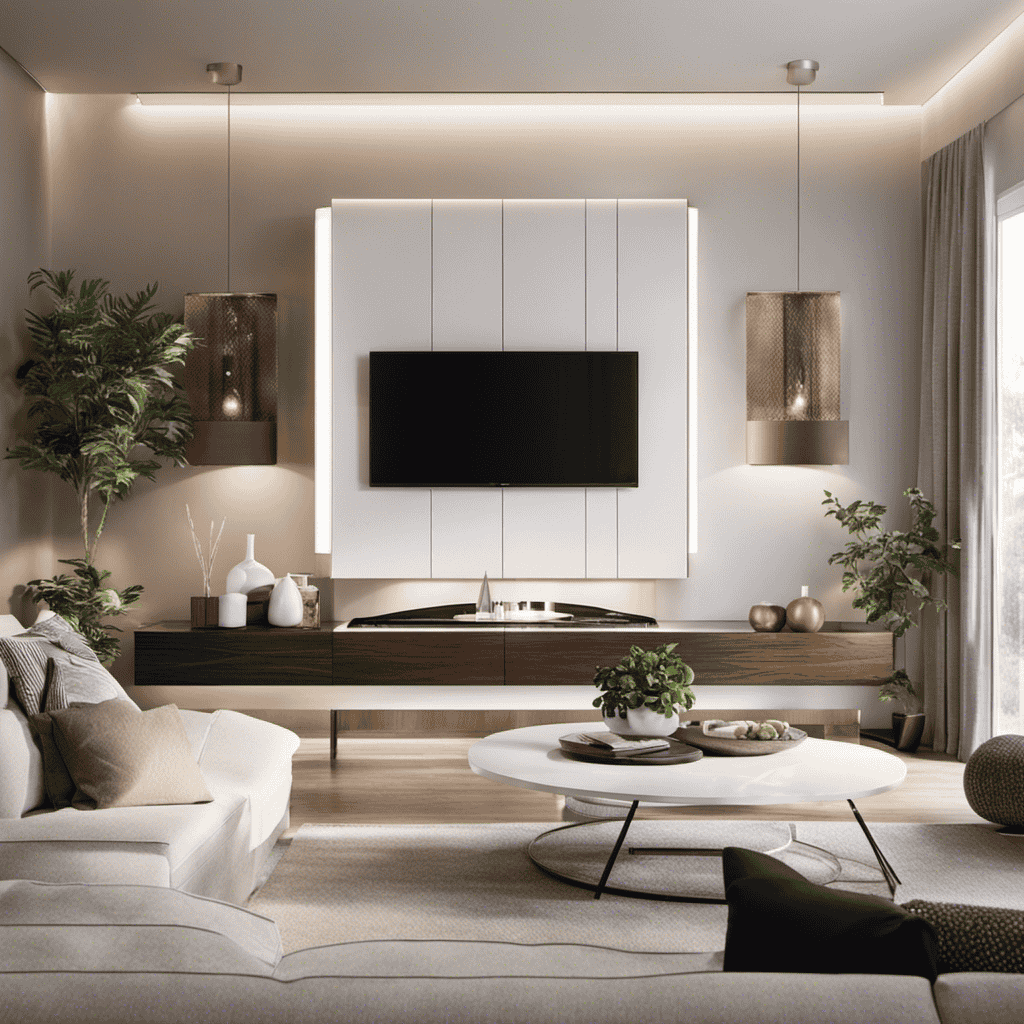
I have always been curious about whether running my air purifier nonstop every day would actually have an impact. After doing some research, I was surprised by the results. It appears that there are some convincing arguments for running your air purifier around the clock.
From improving indoor air quality to reducing the risk of respiratory issues, continuous air purification offers a range of health benefits. Plus, it can enhance sleep quality and even save you money in the long run.
Let’s dive deeper into the science behind it all.
Key Takeaways
- Improved indoor air quality
- Reduced risk of allergies and respiratory issues
- Enhanced sleep quality
- Boosted immune system function
Health Benefits of Running Your Air Purifier 24/7
Running your air purifier 24/7 can greatly improve the air quality in your home, reducing the risk of allergies and respiratory issues. Regular air purifier maintenance is essential to ensure that it functions optimally and continues to provide you with clean air.
By constantly circulating and filtering the air, an air purifier can remove harmful particles such as dust, pollen, pet dander, and mold spores. This is especially beneficial for those with allergies or asthma, as it helps to alleviate symptoms and promote better respiratory health.
Additionally, clean air is important for everyone’s overall well-being. Breathing in clean air can improve sleep quality, enhance cognitive function, and boost immune system function.
Improved Indoor Air Quality With Continuous Air Purification
Constantly clean air is essential for maintaining a healthy indoor environment. With continuous air purification, you can ensure that the air you breathe is free from pollutants and allergens.
This not only improves the quality of the air you breathe but also provides numerous health benefits. For example, it reduces the risk of respiratory issues and allergies.
Constantly Clean Air
You should keep your air purifier on all the time to ensure that the air in your home is always clean. Running your air purifier continuously offers several benefits, including improved indoor air quality and a healthier living environment. Here’s why you should consider running your air purifier 24/7:
-
Energy Consumption: Most modern air purifiers are designed to be energy-efficient. They consume minimal electricity, so you don’t have to worry about high energy bills.
-
Noise Level: Air purifiers are designed to operate quietly, allowing you to enjoy a peaceful environment while still benefiting from clean air.
-
Constantly Clean Air: By running your air purifier all the time, you can maintain a consistent level of air purification, ensuring that pollutants, allergens, and other harmful particles are constantly being removed.
With these factors in mind, it’s clear that running your air purifier continuously is a smart choice for maintaining cleaner and healthier indoor air. In addition to the benefits mentioned, continuous purification also offers various health benefits that we will explore in the next section.
Health Benefits of Continuous Purification
By keeping your air purifier on all the time, you’ll experience improved indoor air quality and enjoy the health benefits of continuous purification. Running your air purifier 24/7 can have a positive impact on your immune system and help reduce allergies.
Air purifiers work by removing airborne particles such as dust, pollen, pet dander, and mold spores from the air, which can trigger allergies and respiratory issues. By continuously purifying the air, your immune system is less likely to be overwhelmed by these allergens, resulting in improved overall health.
Additionally, air purifiers can also help reduce the spread of airborne viruses and bacteria, further supporting your immune system. So, if you want to improve your immune system and reduce allergies, keeping your air purifier on all the time is a wise decision.
Eliminating Allergens and Pollutants Around the Clock
Running my air purifier all day helps to eliminate allergens and pollutants from my home. Here are three ways it improves my overall well-being and reduces allergy symptoms:
-
Cleaner Air: With the air purifier constantly running, it filters out dust, pet dander, pollen, and other airborne particles that trigger allergies. This ensures that the air I breathe is clean and free from allergens.
-
Improved Sleep: By removing irritants from the air, the air purifier helps me sleep better at night. I wake up feeling refreshed and with fewer allergy symptoms, such as congestion or sneezing.
-
Reduced Asthma Triggers: Asthma sufferers like me benefit greatly from running an air purifier 24/7. It removes asthma triggers like mold spores and volatile organic compounds (VOCs), creating a healthier indoor environment.
The Importance of Consistent Air Filtration
Continuous air purification is essential for maintaining a healthy indoor environment. With consistent filtration, we can effectively remove pollutants and allergens from the air, reducing the risk of respiratory issues and other health problems.
Continuous Air Purification
There’s no need to worry about turning off your air purifier because it continuously cleans the air in your home. Here are three benefits of round the clock filtration:
-
Improved Indoor Air Quality: By running your air purifier 24/7, you ensure that the air in your home is constantly being purified. This helps remove harmful pollutants such as dust, pollen, pet dander, and mold spores, leading to cleaner and healthier air for you and your family.
-
Allergen Control: Continuous air purification helps reduce allergens in your home. It can effectively capture and eliminate common allergens, such as pollen and dust mites, providing relief for allergy sufferers.
-
Odor Elimination: Running your air purifier nonstop helps eliminate unpleasant odors, such as cooking smells, pet odors, and tobacco smoke. It can neutralize these odors by trapping and absorbing the particles that cause them.
By keeping your air purifier running constantly, you can enjoy the continuous benefits of clean and fresh air in your home, which can have a positive impact on your overall health and well-being.
In the next section, we will explore the specific health benefits of filtration.
Health Benefits of Filtration
By keeping your air purifier on all the time, you can experience the health benefits of cleaner air in your home. Air purifiers work by filtering out pollutants and contaminants from the air, ensuring that the air you breathe is cleaner and healthier. The filtration process traps particulate matter such as dust, pollen, pet dander, and even bacteria and viruses, reducing the risk of respiratory issues and allergies. Continuous operation of the air purifier ensures that the filtration system is constantly working to remove these harmful particles from the air.
This can lead to improved indoor air quality, reduced symptoms of allergies and asthma, and a healthier living environment overall. So, don’t hesitate to keep your air purifier running all the time to enjoy the full benefits of cleaner air in your home.
Reducing Indoor Air Pollution
To effectively reduce indoor air pollution, it’s important to regularly clean and maintain your air purifier. Here are three key reasons why this is crucial for improving respiratory health and reducing asthma triggers:
-
Efficient Filtration: A clean air purifier can effectively capture and remove airborne particles, such as dust, pet dander, and pollen, which are common triggers for respiratory issues and asthma attacks.
-
Preventing Recirculation: Regular maintenance ensures that the filters in your air purifier are functioning optimally. This prevents the recirculation of pollutants back into the air, keeping the indoor environment cleaner and healthier.
-
Promoting Better Air Quality: By regularly cleaning and maintaining your air purifier, you can enhance its overall performance, allowing it to efficiently clean the air and maintain a higher level of indoor air quality. This can significantly improve respiratory health and reduce asthma triggers for you and your family.
Reducing the Risk of Respiratory Issues by Running Your Air Purifier 24/7
Running your air purifier 24/7 can help you reduce the risk of respiratory issues. Indoor air pollution contains various harmful particles such as dust, pollen, pet dander, and volatile organic compounds (VOCs) that can trigger allergies and respiratory conditions like asthma. By continuously purifying the air, an air purifier can effectively remove these pollutants, providing cleaner and healthier air to breathe. This can lead to improved cognitive function and reduced asthma symptoms.
The constant filtration of the air helps to remove allergens and irritants, promoting better respiratory health. By reducing the risk of respiratory issues, running your air purifier round-the-clock can greatly benefit your overall well-being.
Additionally, enhancing sleep quality with round-the-clock air purification can further improve your health and well-being.
Enhancing Sleep Quality With Round-The-Clock Air Purification
Enhancing sleep quality can be achieved by using an air purifier that operates 24/7. Here are three ways in which running an air purifier round-the-clock can contribute to better sleep and improved well-being:
-
Reduced allergens: An air purifier filters out common allergens like pollen, dust mites, and pet dander, ensuring cleaner air in your bedroom. This can help alleviate allergy symptoms, such as sneezing, congestion, and itchy eyes, which can disrupt sleep.
-
Elimination of odors: Air purifiers with activated carbon filters can effectively remove unpleasant odors from the air, such as cooking smells or cigarette smoke. By eliminating these odors, you can create a more pleasant sleeping environment, promoting relaxation and better sleep.
-
Improved air quality: Air purifiers remove pollutants such as volatile organic compounds (VOCs) and airborne particles, creating cleaner and fresher air to breathe. This can lead to a healthier sleep environment, reducing the risk of respiratory issues and promoting overall well-being.
Energy Efficiency and Cost Savings With 24/7 Air Purifier Usage
By operating an air purifier round-the-clock, you can save on energy and reduce costs. Running an air purifier continuously may seem counterintuitive when it comes to energy savings, but it can actually be more efficient in the long run. Modern air purifiers are designed to be energy-efficient, and running them continuously helps maintain a consistently clean and healthy indoor environment. The energy consumption of an air purifier depends on factors such as the size of the room and the air quality, but most models have low power consumption. Additionally, running an air purifier 24/7 can help reduce the environmental impact by improving indoor air quality and reducing the need for other energy-consuming devices like fans or dehumidifiers.
Here is a table showcasing the potential energy savings and environmental impact of running an air purifier round-the-clock:
| Energy Savings | Environmental Impact |
|---|---|
| Reduced need for other devices | Improved indoor air quality |
| Lower power consumption | Reduced use of fans and dehumidifiers |
| Consistent clean air | Decreased pollutants in the air |
Overall, operating an air purifier continuously can lead to energy savings and a positive environmental impact.
Conclusion
In conclusion, running your air purifier 24/7 is like having a guardian angel for your indoor air quality. It tirelessly fights off allergens and pollutants, giving you a breath of fresh air day and night.
With consistent air filtration, the risk of respiratory issues is greatly reduced, allowing you to breathe easy. Not only does it improve your health, but it enhances your sleep quality as well.
And the best part? It’s energy efficient and saves you money. So why wait? Let your air purifier be your constant protector, purifying the air around you non-stop.
At Aero Guardians, where every piece of information aims to make the world a breath fresher, Samuela’s role as an author has been nothing short of transformative. With a penchant for weaving stories around the science of air purification, Samuela has enriched the platform with content that is both enlightening and captivating.
FAQs - Advanced Queries
Why Is the Air Purifier so Noisy
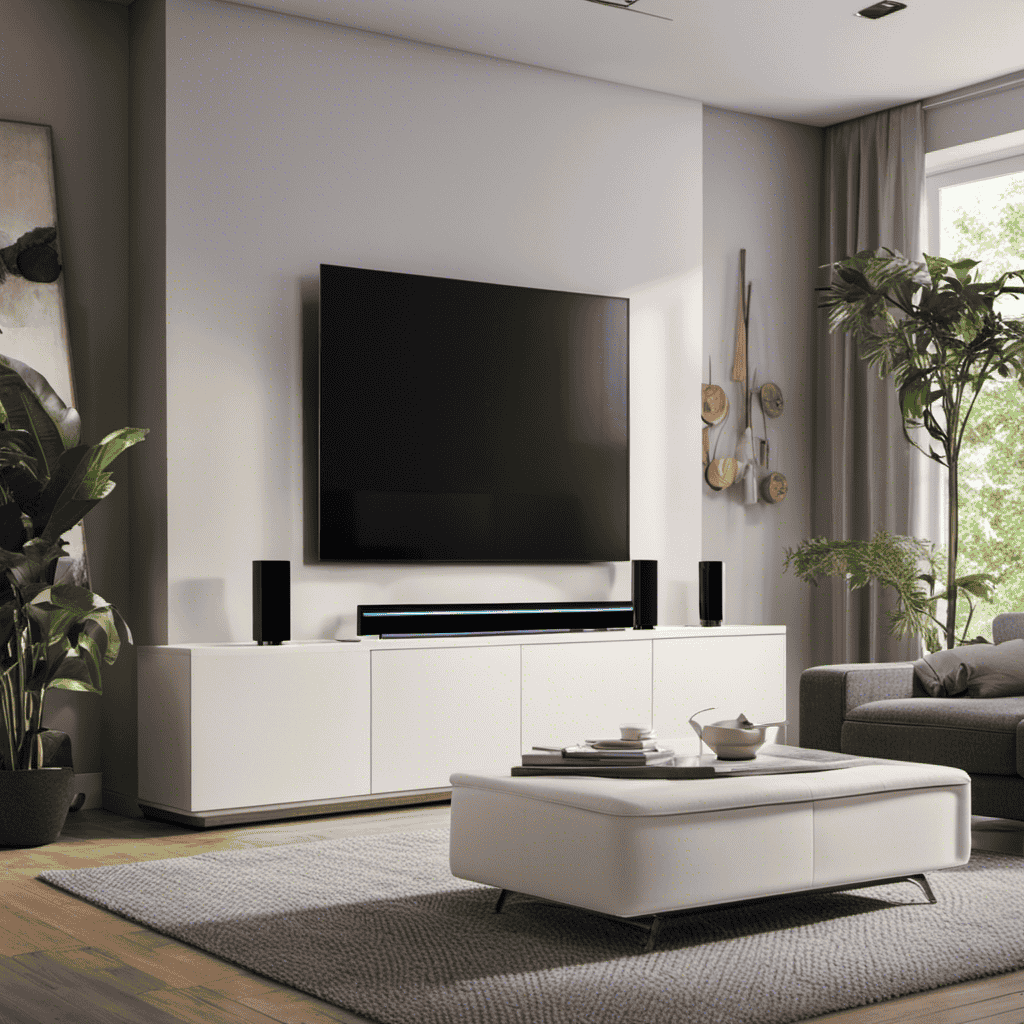
As someone who frequently uses air purifiers, I am constantly bothered by the loud noise they generate. It feels like a small tornado has made its home in my living room.
This article delves into the various causes behind the seemingly relentless racket of air purifiers. By examining factors such as fan noise, motor malfunctions, filter maintenance, and airflow, we aim to shed light on why these devices can be as disruptive as they are beneficial.
Additionally, we will explore practical tips for minimizing the noise and maximizing the peace in our homes.
Key Takeaways
- Dirty or clogged filters restrict airflow and cause the fan to work harder, resulting in more noise.
- Motor speed directly affects fan noise, with higher speeds producing louder noise levels.
- Motor malfunctions such as worn-out bearings or damaged fan blades can lead to increased noise levels.
- Regular filter cleaning and replacement, as well as proper maintenance of the motor, can help reduce noise in air purifiers.
Common Causes of Noisy Air Purifiers
One of the most common causes of noisy air purifiers is a dirty or clogged filter. When the filter becomes dirty, it restricts the flow of air through the purifier, causing the fan to work harder and generate more noise.
To prevent this issue, it’s crucial to regularly clean or replace the filter according to the manufacturer’s instructions.
Another factor that can contribute to noise is the fan speed. Higher fan speeds generally produce more noise due to the increased airflow. Understanding the fan speed settings and adjusting them accordingly can help minimize noise levels while still maintaining optimal air purification.
Additionally, noise reduction techniques such as sound insulation materials or placing the purifier on a stable surface can effectively reduce unwanted noise.
Understanding Fan Noise in Air Purifiers
To better understand the fan noise in air purifiers, it’s helpful to consider factors such as motor speed and blade design. The motor noise is directly related to the fan speed, with higher speeds generally resulting in louder noise levels. Additionally, the design of the fan blades can impact the noise produced. Blades with a more streamlined shape and optimized pitch can reduce turbulence and minimize noise. Other factors that contribute to fan noise include the quality of the motor bearings, the presence of vibration dampening mechanisms, and the overall construction of the air purifier housing.
By taking all these factors into account, manufacturers can create air purifiers that deliver effective purification while minimizing fan noise.
Transitioning into the subsequent section about ‘motor malfunctions and noise levels’, it’s important to note that even with proper design and maintenance, motors can sometimes malfunction, leading to increased noise levels.
Motor Malfunctions and Noise Levels
When motors malfunction, the noise levels can become noticeably louder. Motor malfunction effects vary depending on the specific issue, but common problems include worn-out bearings, loose components, or damaged fan blades. These issues can lead to excessive vibrations and increased noise levels.
To minimize the noise caused by motor malfunctions, several noise reduction methods can be implemented. One approach is to use vibration isolators or dampeners to absorb and reduce the vibrations produced by the malfunctioning motor.
Additionally, regular maintenance and inspection of the motor can help identify and address any potential issues before they escalate and cause increased noise levels.
Lastly, replacing worn-out or damaged components, such as fan blades or bearings, can also help restore the motor’s functionality and reduce noise.
How Filter Maintenance Affects Noise Levels
Dirty filters can significantly increase the noise levels of an air purifier. When the filter becomes clogged with dust and debris, it obstructs the airflow, forcing the motor to work harder and produce more noise.
Regular filter cleaning is crucial to maintain optimal performance and reduce noise levels in the long run. Additionally, replacing the filter when necessary can further minimize noise by ensuring proper air circulation and preventing the motor from overworking.
Dirty Filters Increase Noise
You can reduce the noise of your air purifier by cleaning or replacing the filters regularly. Dirty filters can cause the fan speed to increase, leading to louder operation.
Here are some noise reduction techniques to consider:
- Clean or replace filters every 3-6 months to maintain optimal performance.
- Use high-quality filters that are specifically designed for noise reduction.
- Place the air purifier on a stable surface to minimize vibrations and rattling sounds.
- Keep the air purifier away from walls or other objects that may obstruct airflow.
- Consider using a lower fan speed setting, as higher speeds tend to generate more noise.
Regular Filter Cleaning
To maintain optimal performance, it’s important to regularly clean or replace your air purifier filters. This is especially crucial for reducing noise levels and ensuring a quieter operation.
When the filters become dirty or clogged, the fan has to work harder to draw in air, resulting in increased noise. By regularly cleaning the filters, you can prevent this buildup and maintain efficient airflow.
Start by turning off the purifier and removing the filters. Use a vacuum cleaner or a soft brush to gently remove dust and debris from the filters and the fan blades. Make sure to follow the manufacturer’s instructions for proper cleaning techniques.
Regular filter cleaning not only improves air quality but also reduces noise, creating a more peaceful environment in your home.
Filter Replacement Reduces Noise
Replacing your filters regularly can greatly reduce the noise levels emitted by your air purifier. When filters become clogged with dust and debris, the air purifier has to work harder to pull air through, resulting in increased noise. By replacing filters on a regular basis, you can maintain optimal airflow and minimize noise.
Here are some benefits of filter replacement for noise reduction:
-
Improved air circulation: Clean filters allow for better airflow, reducing strain on the air purifier and decreasing noise.
-
Enhanced efficiency: New filters ensure that the air purifier is operating at maximum efficiency, reducing noise caused by inefficiencies.
-
Reduced motor wear and tear: With clean filters, the motor doesn’t have to work as hard, leading to quieter operation.
-
Longer lifespan: Regular filter replacement prolongs the lifespan of your air purifier, reducing the likelihood of noise-related issues.
-
Enhanced air quality: Fresh filters remove more contaminants, allowing the air purifier to operate more quietly while maintaining clean air.
The Impact of Airflow and Noise
When the air purifier is operating at high airflow levels, it can become noisy and potentially disrupt your daily activities. This is because the increased airflow generates more noise as it moves through the purifier’s components. To address this issue, manufacturers focus on improving airflow efficiency and implementing noise reduction techniques. By optimizing the design and placement of the internal components, they can reduce turbulence and minimize vibrations that contribute to noise. Additionally, advanced sound insulation materials are used to absorb and dampen the noise generated during operation. These efforts result in quieter air purifiers that provide effective purification without causing excessive noise pollution. In the table below, I have summarized some common noise reduction techniques used in air purifiers:
| Noise Reduction Techniques |
|---|
| Design optimization |
| Component placement |
| Sound insulation materials |
| Vibration damping |
| Noise-absorbing filters |
Tips for Reducing Noise From Your Air Purifier
When it comes to air purifiers, one of the biggest concerns for users is the noise level. In this discussion, I will explore various noise-reducing techniques that can be implemented to minimize the disturbance caused by air purifiers.
Additionally, I will delve into the concept of silent air purifiers and their effectiveness in providing a quiet and peaceful environment.
Noise-Reducing Techniques
To reduce the noise of your air purifier, try adjusting the fan speed or placing it on a soft surface. These simple steps can significantly decrease the noise produced by your device.
However, if you’re looking for more advanced solutions, there are noise reducing technologies and soundproofing techniques available. Consider the following options:
- Noise reducing technology: Some air purifiers come equipped with advanced noise reduction features, such as vibration isolation pads or sound-absorbing materials.
- Soundproofing techniques: You can soundproof the area around your air purifier by using soundproof curtains, acoustic panels, or even a white noise machine to mask the noise.
By implementing these techniques, you can create a quieter environment while still enjoying the benefits of clean air.
Now, let’s explore the next section about silent air purifiers and how they can further minimize noise.
Silent Air Purifiers
Silent air purifiers offer a noise-free solution for those seeking a quieter environment. These innovative devices utilize advanced noise-reducing technologies to ensure a peaceful atmosphere without compromising on air quality. By employing cutting-edge engineering and design, silent air purifiers effectively remove airborne pollutants while operating silently in the background.
One of the key features of silent air purifiers is their incorporation of noise reducing technologies. These technologies include sound-dampening materials, advanced fan designs, and vibration isolation systems. By minimizing the noise generated by the purifier’s components, these devices create a more serene environment for users.
To illustrate the effectiveness of silent air purifiers, let’s take a look at the following table showcasing some popular models and their noise levels:
| Model | Noise Level (dB) | Coverage Area (sq. ft.) |
|---|---|---|
| A | 25 | 300 |
| B | 30 | 500 |
| C | 35 | 800 |
| D | 40 | 1000 |
As you can see, these silent air purifiers operate at low noise levels, allowing you to enjoy cleaner air without the distractions of loud machinery. Whether it’s for your bedroom, office, or any other space, silent air purifiers provide a peaceful environment while effectively improving indoor air quality.
Noise Level Comparison
These innovative devices offer a quieter environment by incorporating noise-reducing technologies. When comparing noise levels of different air purifiers, it is important to consider the following factors:
- Sound insulation: Some air purifiers are designed with special materials that help absorb and reduce noise.
- Fan speed control: A silent air purifier brand may offer multiple fan speed settings, allowing you to adjust the noise level according to your preference.
- Filter design: Certain air purifiers use advanced filter designs that optimize airflow while minimizing noise.
- Vibration reduction: Manufacturers may incorporate vibration-dampening technologies to reduce noise caused by motor vibrations.
- Smart features: Some air purifiers come with smart sensors that detect the air quality and adjust the fan speed accordingly, resulting in a quieter operation.
Frequently Asked Questions
Can Noisy Air Purifiers Affect My Sleep Quality?
Noisy air purifiers can negatively impact sleep quality. Excessive noise can disrupt sleep patterns, leading to poor sleep and overall health issues. To reduce noise, consider placing the purifier in a separate room or using a quieter model.
Can Air Purifiers Make My Allergies Worse Due to the Noise They Produce?
Yes, air purifiers can potentially cause hearing damage due to their high noise levels. However, there are ways to reduce the noise without compromising effectiveness, such as using noise-cancelling technology or placing the purifier in a soundproofed area.
Are There Any Specific Brands or Models of Air Purifiers That Are Known for Being Quieter?
Quiet air purifiers can be found in various brands and models. Noise reduction techniques, such as sound insulation and fan design, are employed to minimize noise. These advancements ensure a peaceful environment while maintaining effective air purification.
Can I Use My Air Purifier in a Bedroom or Office Without Disturbing Others With the Noise?
I can use my air purifier in a bedroom or office without disturbing others with the noise. By selecting a model with lower air purifier noise levels and implementing tips for reducing noise, such as placing it on a stable surface and cleaning the filters regularly.
How Can I Tell if the Noise Coming From My Air Purifier Is Normal or if There Is a Malfunction?
To determine if the noise from my air purifier is normal or a malfunction, I can follow these troubleshooting tips: check for loose parts, clean or replace filters, and ensure proper placement and ventilation.
Conclusion
In conclusion, noisy air purifiers can be attributed to various factors. These factors include fan noise, motor malfunctions, and filter maintenance. The airflow and noise levels are directly linked, impacting the overall noise produced by the device.
To reduce noise, consider cleaning or replacing filters regularly. Additionally, ensure proper maintenance of the motor. Just like a well-tuned engine purrs smoothly, a well-maintained air purifier operates silently. This allows you to enjoy clean and fresh air without any disruptions.
So, take care of your air purifier, and it will take care of you.
In the dynamic world of air purifiers and clean air advocacy, Aire stands out as a beacon of knowledge and passion. As the Editor in Chief of Aero Guardians, Aire has been instrumental in shaping the platform’s voice and direction, ensuring that every piece of content resonates with clarity, authority, and authenticity.
-

 Air Purifier Guides8 months ago
Air Purifier Guides8 months agoHow to Reset Filter on Miko Air Purifier
-
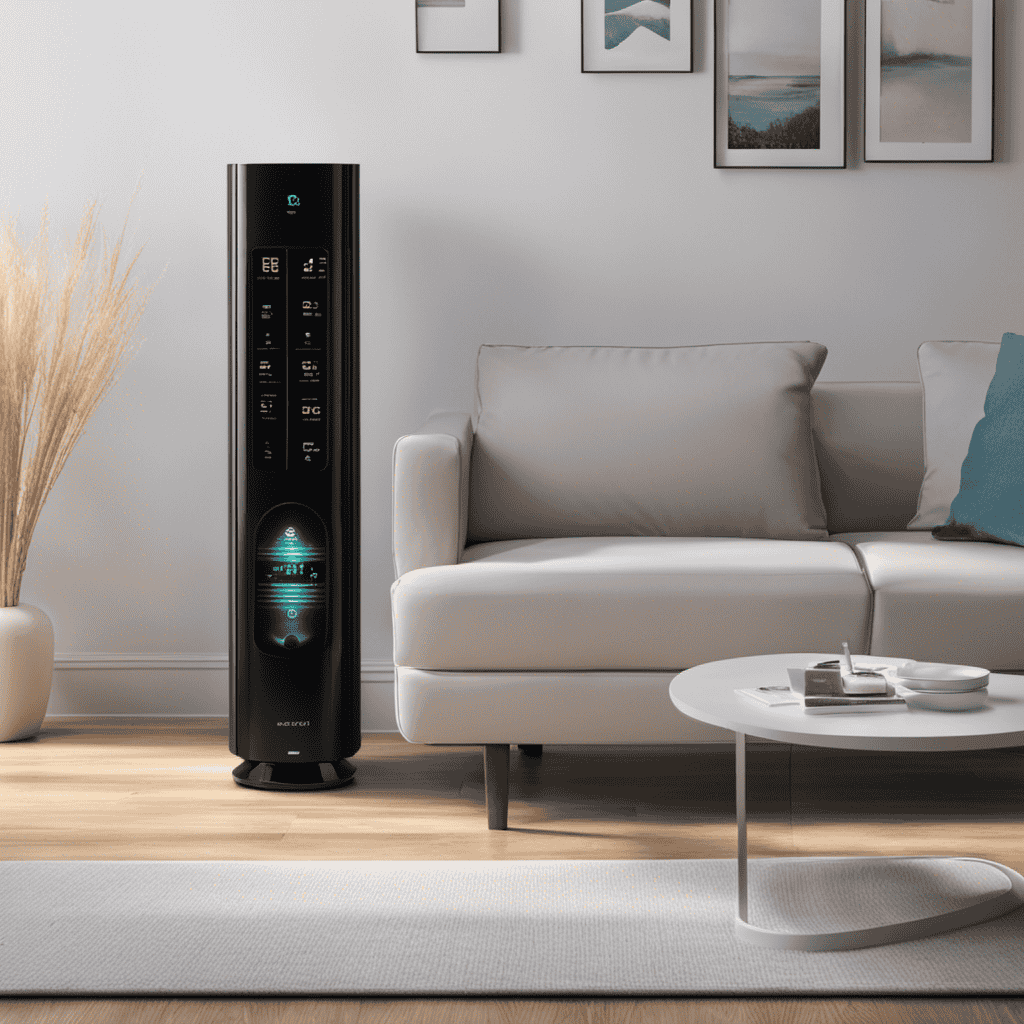
 FAQs - Advanced Queries5 months ago
FAQs - Advanced Queries5 months agoWhat Do the Numbers on My Air Purifier Mean
-

 Air Purifier Guides6 months ago
Air Purifier Guides6 months agoHow to Make a Homemade Ozone Generator (Air Purifier
-
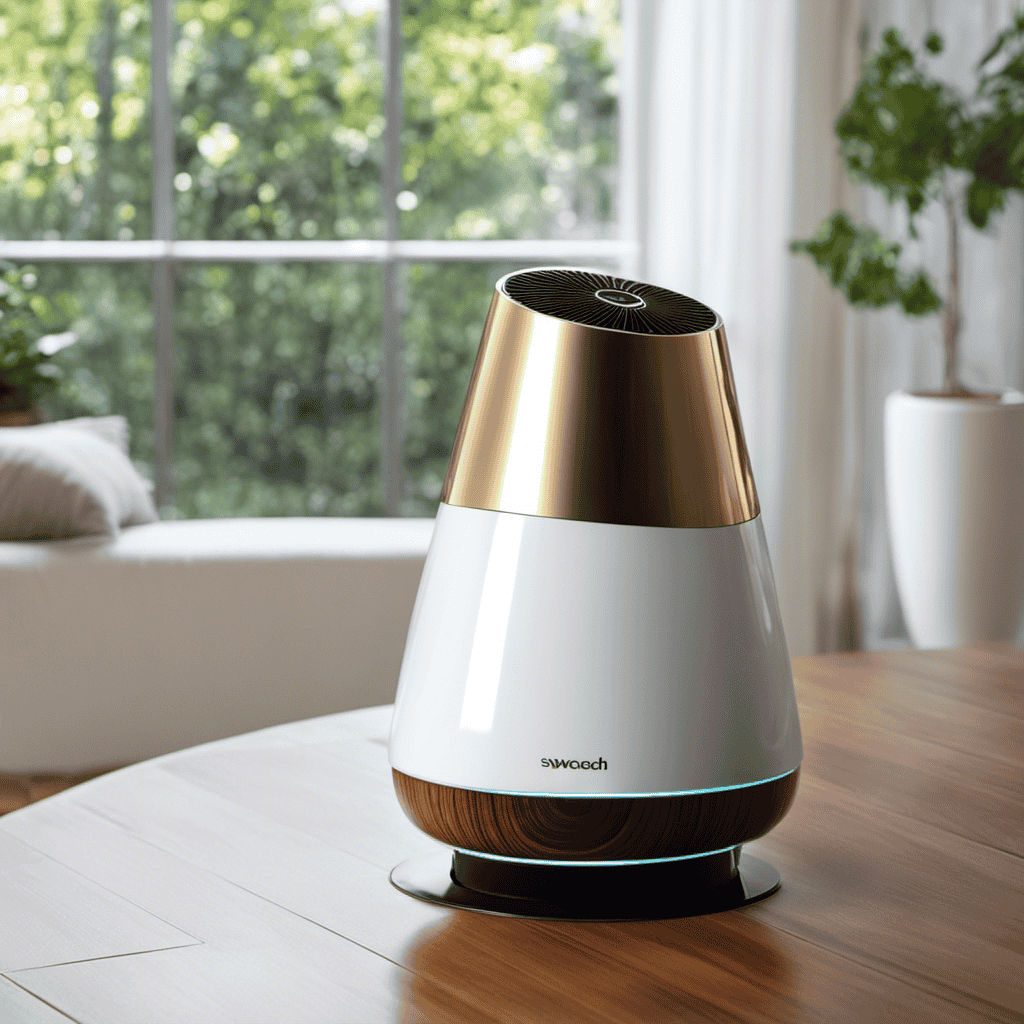
 Types of Air Purifiers9 months ago
Types of Air Purifiers9 months agoWhat Is an Air Purifier
-

 Vetted7 months ago
Vetted7 months agoAera Mini Review: Smart Home Fragrance Diffuser With Hypoallergenic Scent Technology (2023)
-
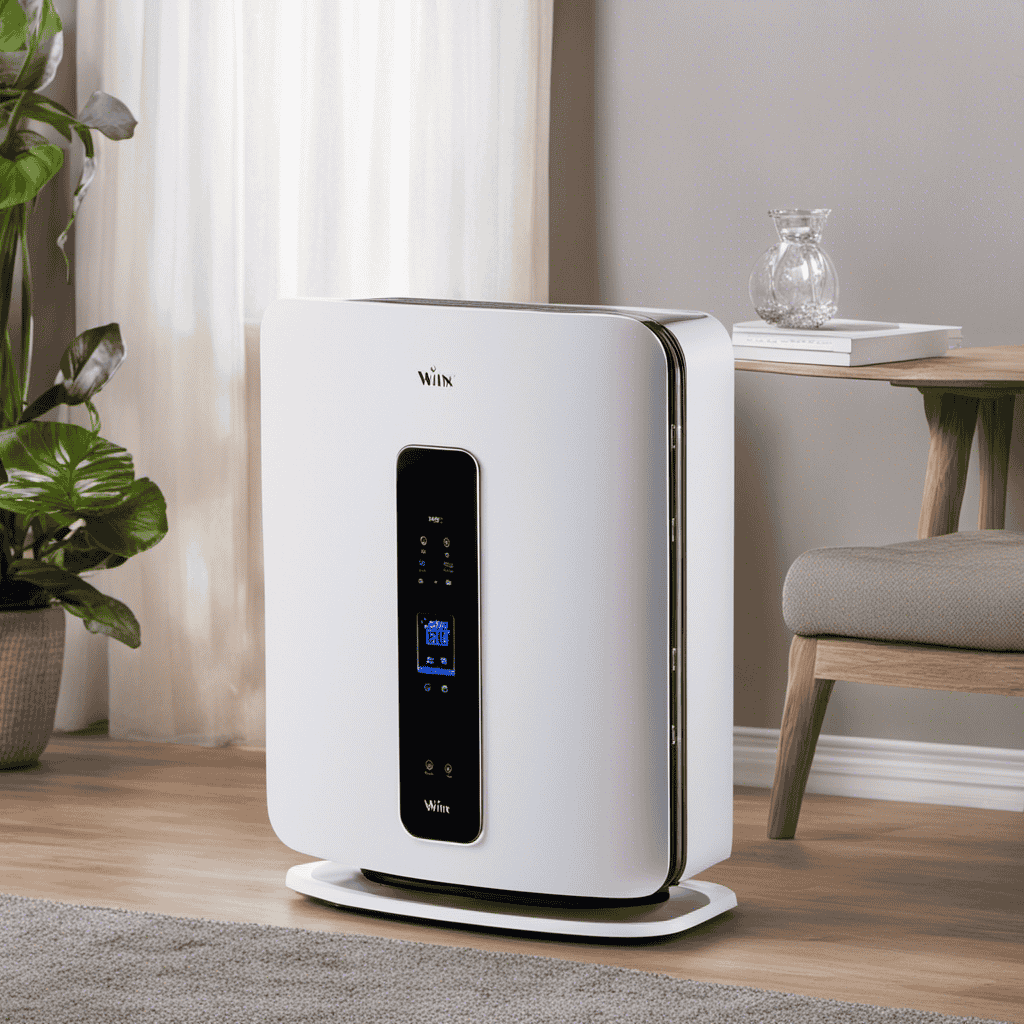
 Maintenance and Tips10 months ago
Maintenance and Tips10 months agoHow to Reset Filter Light on Winix Plasmawave Air Purifier
-
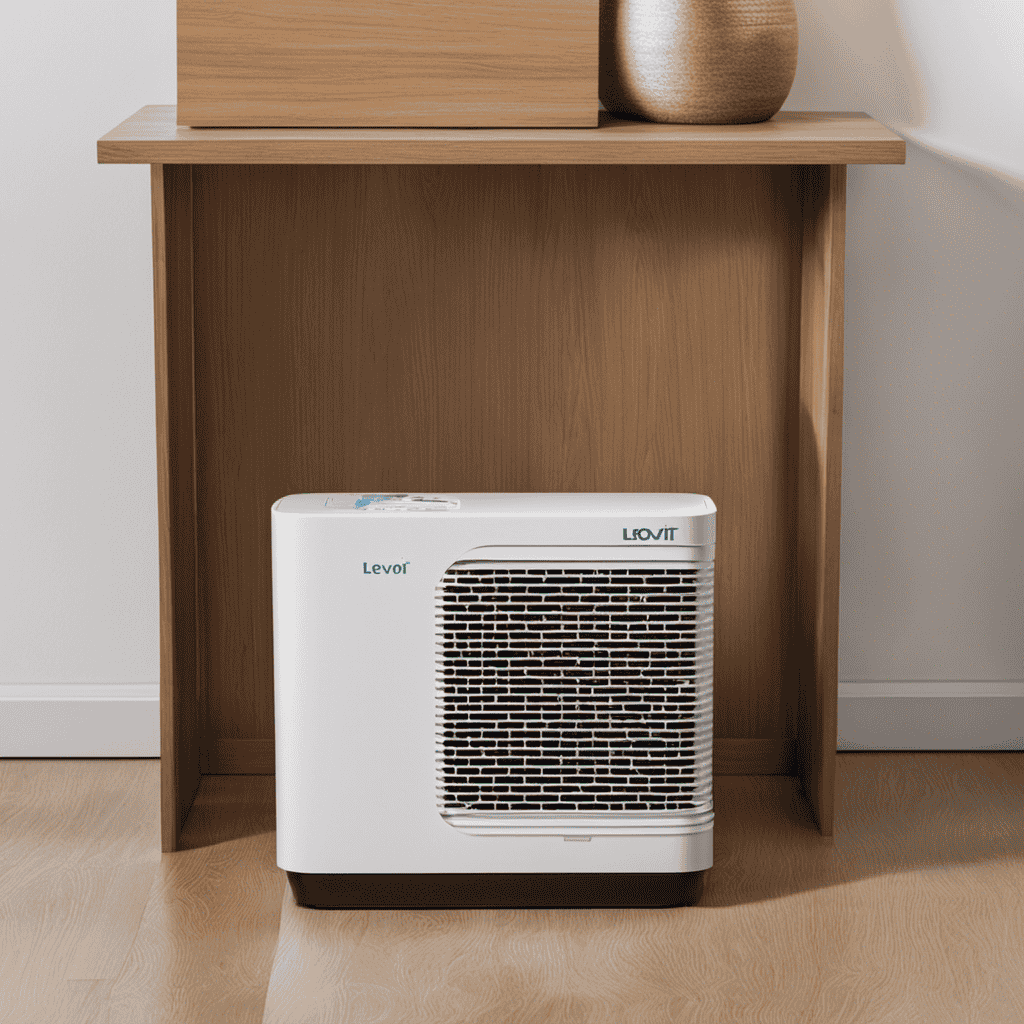
 Air Purifier Guides4 days ago
Air Purifier Guides4 days agoHow to Dispose of Air Purifier Filter Levoit
-

 FAQs - Advanced Queries3 weeks ago
FAQs - Advanced Queries3 weeks agoWhen to Use Ionizer on Coway Air Purifier





